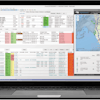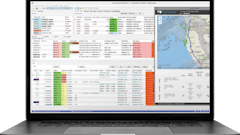Company enters software applications market with solution designed to produce more realistic plans and user-directed policy management
Mountain View, CA — April 8, 2005 — Solution provider ILOG this week debuted a new transportation planning application intended to support complex transportation networks and detailed customer requirements.
ILOG said its new Transport PowerOps (TPO) solution, the first release from the company's new PowerOps Suite, will allow shippers to create more realistic plans compared with other solutions on the market, enabling them to better control costs and increase efficiency.
"With ILOG TPO, shippers can have a planning process that is connected and streamlined, versus having the consolidation, carrier selection and scheduling tasks performed separately," the solution provider said in announcing the new application, which is targeted at third-party logistics providers (3PLs), retailers and consumer packaged goods manufacturers with complex planning requirements.
Expanding TMS Market
Today's announcement gives ILOG a larger role in the transportation management systems (TMS) market, which, according to research firm ARC Advisory Group, reached $873 million in 2003, and is forecasted to grow to $1.2 billion by the end of 2008, representing a compound annual growth rate of 7.1 percent. Previously, ILOG provided only optimization software components to the TMS market. The company said it would continue to provide these components to end-users and its software partners.
Increasing fuel costs, as well as changes in service hours and capacity, have significantly hit profits for both transportation providers and their customers. In response, both groups want to gain advantage by better managing the trade offs between performance metrics, like on-time delivery and utilization, and the costs of service.
Prior to the availability of ILOG's TPO, customers were forced to use manual planning or would have to model warehouse, yard and transportation operations separately. The resulting gaps between reality and the models can decrease efficiency, affecting profitability, ILOG said. In addition, shippers and carriers alike are looking for more flexibility and control over the parameters of their transportation management, as well as the savings and agility that result when they give control of business policies to their end-users.
Controlling Costs, Boosting Profits
ILOG said that TPO will help shippers and carriers alike better control costs and boost profitability by providing better support for the increasingly complex transportation planning environment, including the trend in the industry towards more complex transportation network designs, such as pool points and cross-docks. In addition, ILOG said that TPO provides more detailed (and realistic) facility resource modeling, allowing customers to model far beyond how many dock doors are at a site, for example, but also the number of forklifts, exit gates and even how many people are available down to the minute.
And because the new product provides for more granular scheduling, congestion and waiting times can be reduced or even eliminated, according to the solution provider. For example, at a warehouse expecting 100 trucks a day, the truck arrivals could be scheduled according to the actual resources required to load the shipments.
For carriers and private fleet owners, ILOG said that TPO contributes to lower fuel costs by providing detailed plans that reduce the miles driven, reduce waiting times at warehouses and plants, as well as maximize vehicle utilization while minimizing the number of vehicles necessary — all contributing to higher overall profitability.
These benefits are possible, ILOG said, because Transport PowerOps combines three technologies for the first time: interactive visualization to realistically depict transportation assets; business rule management to change customer parameters as often as necessary; and resource optimization technology, which automatically balances asset utilization and costs against service levels and delivers the optimized transportation plan based on available resources.
Available on April 11, TPO has five major components: an interactive map and schedule view; a transportation server, which manages scenarios; an optimization engine that generates the plan and evaluates plan edits; a business rule management system to enable user-directed business policy management; and an underlying object model for logistics operations.
Additional Articles of Interest
For more information on the latest trends in the logistics space, see the article "The Analyst Corner: Fulfillment & Logistics" in the October/November 2004 issue of Supply & Demand Chain Executive.
Mountain View, CA — April 8, 2005 — Solution provider ILOG this week debuted a new transportation planning application intended to support complex transportation networks and detailed customer requirements.
ILOG said its new Transport PowerOps (TPO) solution, the first release from the company's new PowerOps Suite, will allow shippers to create more realistic plans compared with other solutions on the market, enabling them to better control costs and increase efficiency.
"With ILOG TPO, shippers can have a planning process that is connected and streamlined, versus having the consolidation, carrier selection and scheduling tasks performed separately," the solution provider said in announcing the new application, which is targeted at third-party logistics providers (3PLs), retailers and consumer packaged goods manufacturers with complex planning requirements.
Expanding TMS Market
Today's announcement gives ILOG a larger role in the transportation management systems (TMS) market, which, according to research firm ARC Advisory Group, reached $873 million in 2003, and is forecasted to grow to $1.2 billion by the end of 2008, representing a compound annual growth rate of 7.1 percent. Previously, ILOG provided only optimization software components to the TMS market. The company said it would continue to provide these components to end-users and its software partners.
Increasing fuel costs, as well as changes in service hours and capacity, have significantly hit profits for both transportation providers and their customers. In response, both groups want to gain advantage by better managing the trade offs between performance metrics, like on-time delivery and utilization, and the costs of service.
Prior to the availability of ILOG's TPO, customers were forced to use manual planning or would have to model warehouse, yard and transportation operations separately. The resulting gaps between reality and the models can decrease efficiency, affecting profitability, ILOG said. In addition, shippers and carriers alike are looking for more flexibility and control over the parameters of their transportation management, as well as the savings and agility that result when they give control of business policies to their end-users.
Controlling Costs, Boosting Profits
ILOG said that TPO will help shippers and carriers alike better control costs and boost profitability by providing better support for the increasingly complex transportation planning environment, including the trend in the industry towards more complex transportation network designs, such as pool points and cross-docks. In addition, ILOG said that TPO provides more detailed (and realistic) facility resource modeling, allowing customers to model far beyond how many dock doors are at a site, for example, but also the number of forklifts, exit gates and even how many people are available down to the minute.
And because the new product provides for more granular scheduling, congestion and waiting times can be reduced or even eliminated, according to the solution provider. For example, at a warehouse expecting 100 trucks a day, the truck arrivals could be scheduled according to the actual resources required to load the shipments.
For carriers and private fleet owners, ILOG said that TPO contributes to lower fuel costs by providing detailed plans that reduce the miles driven, reduce waiting times at warehouses and plants, as well as maximize vehicle utilization while minimizing the number of vehicles necessary — all contributing to higher overall profitability.
These benefits are possible, ILOG said, because Transport PowerOps combines three technologies for the first time: interactive visualization to realistically depict transportation assets; business rule management to change customer parameters as often as necessary; and resource optimization technology, which automatically balances asset utilization and costs against service levels and delivers the optimized transportation plan based on available resources.
Available on April 11, TPO has five major components: an interactive map and schedule view; a transportation server, which manages scenarios; an optimization engine that generates the plan and evaluates plan edits; a business rule management system to enable user-directed business policy management; and an underlying object model for logistics operations.
Additional Articles of Interest
For more information on the latest trends in the logistics space, see the article "The Analyst Corner: Fulfillment & Logistics" in the October/November 2004 issue of Supply & Demand Chain Executive.
- More articles about ILOG.

![Pros To Know 2026 [color]](https://img.sdcexec.com/mindful/acbm/workspaces/default/uploads/2025/08/prostoknow-2026-color.mduFvhpgMk.png?auto=format%2Ccompress&bg=fff&fill-color=fff&fit=fill&h=100&q=70&w=100)



![Pros To Know 2026 [color]](https://img.sdcexec.com/mindful/acbm/workspaces/default/uploads/2025/08/prostoknow-2026-color.mduFvhpgMk.png?ar=16%3A9&auto=format%2Ccompress&bg=fff&fill-color=fff&fit=fill&h=135&q=70&w=240)








